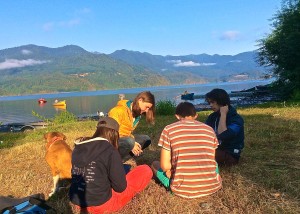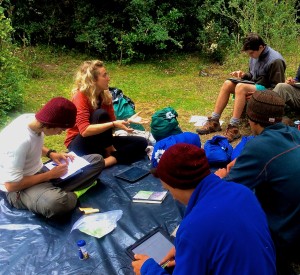Hybrid Education
Imagine “a newer world where the point of education is not rote and drill, but wonder and awe; where schools use the power of the natural world to stimulate learning and creativity; where “hybrid minds” are nurtured, amplifying the sensory and creative benefits of both virtual and natural experience.” – Richard Louv, The Nature Principle
During the course of a semester at the Alzar School we try to utilize Louv’s idea of using “the power of the natural world to stimulate” what we might call traditional learning. Throughout out time in Chile, which is soon coming to an end, we have been away from our traditional classrooms in Idaho. Instead we have spent the last six weeks in our new classrooms – the beach in Choshuenco, the banks of The Río Petrohué, and below the granite walls of the Cochamó Valley.
In one of these new classrooms, underneath the glacial covered Volcán Osorno, students in Chemistry class finished learning about gas law principles and could start to make the real world connections about the way gasses affect our climate presently. Students also sat down in a field, surrounded by the granite walls and forested paths of Cochamó Valley for English class to read Pablo Neruda and create their own odes to their most valued possession that they had with them in the backcountry. Their answers ranged from toilet paper and peanut butter to hiking boots and sleeping bags. These places are just two of the many that have instilled wonder and awe within our students and connected their studies to the natural world around them.
At The Alzar School we require our students to carry an iPad that contains academic apps and school readings necessary for them to continue their academics on and off expeditions. Although this might seem like a bizarre concept to some, that is bringing technology into the wilderness, Alzar reinforces Louv’s idea of “the hybrid mind”. This is what we try to instill within our students – the balance between our minds being focused in a technology that we have available to us, as well as being present in our natural surroundings. We ask, “How can we use technology to benefit us but not lose ourselves in it?”
It might be as simple as utilizing the textbooks downloaded on their iPad, but normally we try to balance the use of technology and our experience in the outdoors. Students will use different apps to write English essays about where they came from after getting to spend time in new cultural settings. They will record Spanish conversational challenges and translate them into English before Instasharing them to their teachers. They will snap photos of the rivers we paddle on and camp next too and write up lab reports about the impact of damning for hydroelectric plants and its effects on the surrounding habitats.
We try as best we can, as Louv says, to use our surroundings that we travel through to amplify our learning and creativity through being a part of our natural surroundings, which in our generation, now includes technology.


